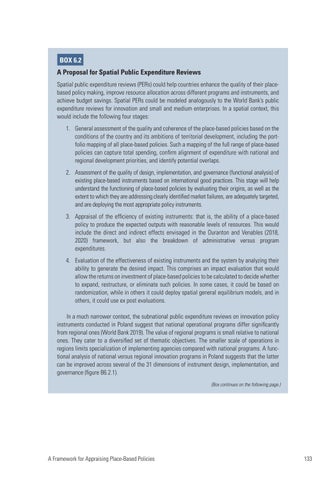BOX 6.2 A Proposal for Spatial Public Expenditure Reviews Spatial public expenditure reviews (PERs) could help countries enhance the quality of their placebased policy making, improve resource allocation across different programs and instruments, and achieve budget savings. Spatial PERs could be modeled analogously to the World Bank’s public expenditure reviews for innovation and small and medium enterprises. In a spatial context, this would include the following four stages: 1. General assessment of the quality and coherence of the place-based policies based on the conditions of the country and its ambitions of territorial development, including the portfolio mapping of all place-based policies. Such a mapping of the full range of place-based policies can capture total spending, confirm alignment of expenditure with national and regional development priorities, and identify potential overlaps. 2. Assessment of the quality of design, implementation, and governance (functional analysis) of existing place-based instruments based on international good practices. This stage will help understand the functioning of place-based policies by evaluating their origins, as well as the extent to which they are addressing clearly identified market failures, are adequately targeted, and are deploying the most appropriate policy instruments. 3. Appraisal of the efficiency of existing instruments: that is, the ability of a place-based policy to produce the expected outputs with reasonable levels of resources. This would include the direct and indirect effects envisaged in the Duranton and Venables (2018, 2020) framework, but also the breakdown of administrative versus program expenditures. 4. Evaluation of the effectiveness of existing instruments and the system by analyzing their ability to generate the desired impact. This comprises an impact evaluation that would allow the returns on investment of place-based policies to be calculated to decide whether to expand, restructure, or eliminate such policies. In some cases, it could be based on randomization, while in others it could deploy spatial general equilibrium models, and in others, it could use ex post evaluations. In a much narrower context, the subnational public expenditure reviews on innovation policy instruments conducted in Poland suggest that national operational programs differ significantly from regional ones (World Bank 2019). The value of regional programs is small relative to national ones. They cater to a diversified set of thematic objectives. The smaller scale of operations in regions limits specialization of implementing agencies compared with national programs. A functional analysis of national versus regional innovation programs in Poland suggests that the latter can be improved across several of the 31 dimensions of instrument design, implementation, and governance (figure B6.2.1). (Box continues on the following page.)
A Framework for Appraising Place-Based Policies
133
